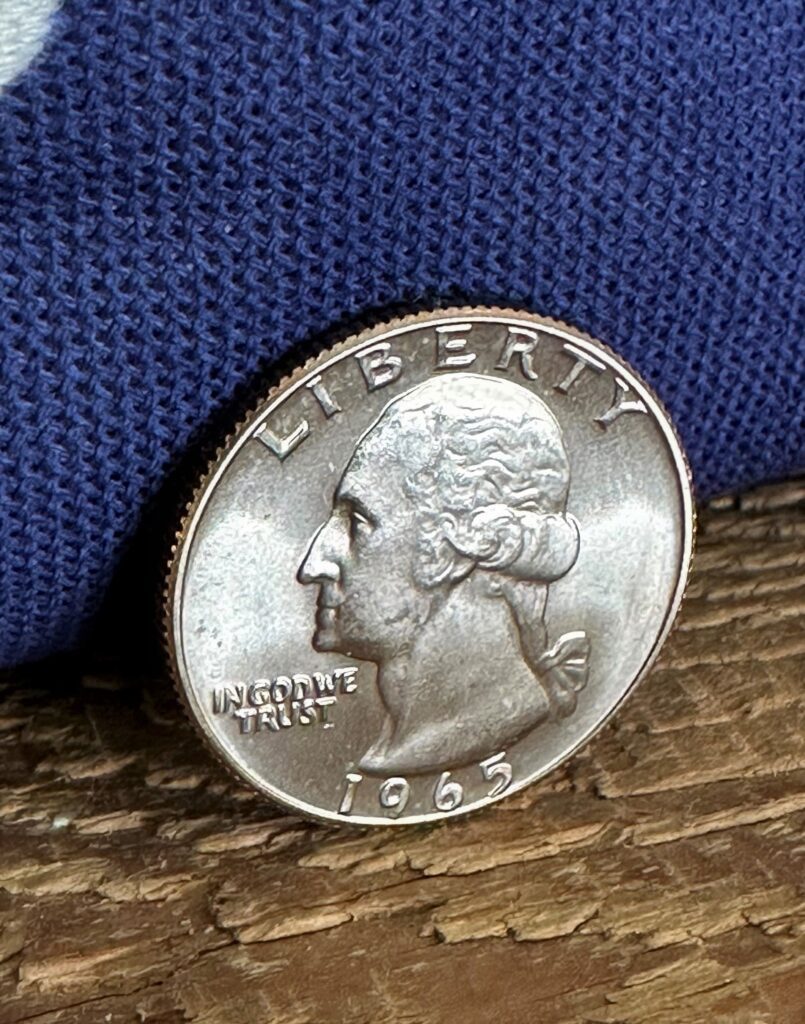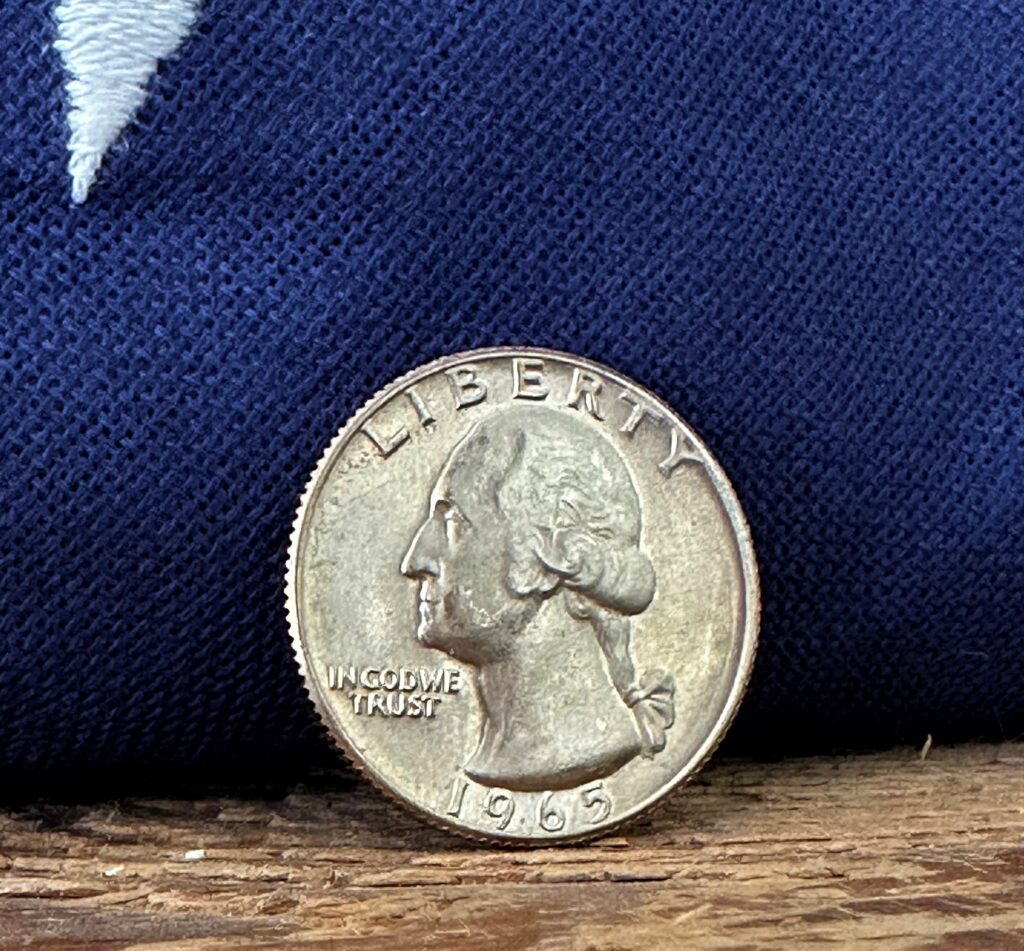The 1965 quarter is one of the most remarkable quarters in U.S. history. It featured a new “clad composition,” in which two different colored metals were bonded together.
The U.S. Mint covered the pure copper core with a blend of copper and nickel, with no mint mark, regardless of where the coin was struck.
If you’re a new coin collector learning about coin values, there’s a lot to learn about the history of the 1965 quarter.
It tells the story of a unique period in the U.S. Mint’s past: the 1964–65 transition year from silver quarters to copper-nickel clad coins.
If you’re browsing your local coin shop and lucky enough to find a 1965 error coin, it could be worth much more than the face value of the quarter.
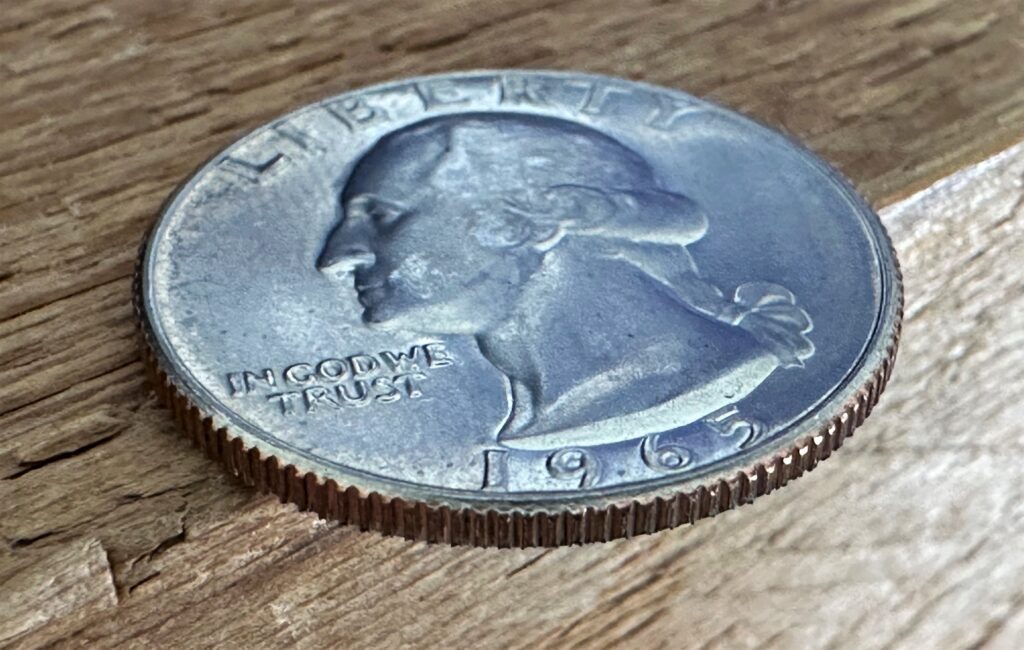
How Much is a 1965 Quarter Worth?
I understand you have a 1965 quarter in your hand, and you just want a simple answer. How much is a 1965 quarter worth? The simple answer is a Washington quarter in circulated condition minted in 1965 is worth $0.35 cents to $1.00.
But first, you need to find out exactly what type of coin you are holding in your hand beyond just the date. Then, you can find the approximate value.
Here are the questions you will need to answer before you can find the exact value of your 1965 quarter.
- Does the 1965 quarter contain silver?
- Can you tell if a 1965 quarter is silver?
- Do you have a rare 1965 Washington quarter error coin?
- What type of condition is your quarter in?
Keep reading, and you’ll be able to answer these simple questions. But first, let’s learn about how the 1965 Washington quarter became so important.
Little-Known 1965 Quarter Facts
- There were 2.3 million Special Mint Set 1965 quarters struck.
- Almost 2 billion 1965 Washington quarters were struck for circulation usage, the highest yearly strike total of any Washington quarter production year.
- 1965 silver quarters do exist, and a few of them are highly valuable and desirable for collectors. In 2021, Heritage Auctions sold a 1965 quarter dollar struck in 90% silver. If you think you might own a 90% silver 1965 quarter, grab a scale. The weight should be 6.2 grams.
- When the U.S. Mint decided to remove the silver and make all coinage clad after 1964, the silver-rich western states we not very happy. The politicians from these states would not vote for the composition change unless the Mint agreed to keep half-dollars with 40% silver. So that’s what the U.S. Mint had to do, all clad coins after 1964 except for half-dollars. Half-dollars were struck with silver until 1971 when they also went to clad.
- Special Mint Set (SMS) 1965 quarters are not proofs. The difference is they were not struck using the highest quality blanks, and were only struck once. Proof coins are struck at least twice, and the coin presses do not strike proof coins as fast as circulation coins.

History of the 1965 Quarter
Toward the end of 1964, a coin shortage was causing chaos in commerce throughout the country.
Even though gold prices remained stable, the price of silver rose sharply in 1963 and 1964, which meant the intrinsic value of silver Kennedy half-dollars and Roosevelt dimes exceeded their face value.
The public hoarded them, putting additional strain on the circulating coinage.
Congress reduced the regular production of U.S. coins by 10 percent in 1963 and another 5 percent in 1964. The reductions applied to all denominations except dimes and quarters, making most coins harder to find in circulation.
The Mint produced “proof” coins for collectors in large numbers, which is standard procedure. But it was selling the coins at a premium rather than shipping them to banks for circulation as it does today.
Changing The 1965 Quarter Metal
President Lyndon Johnson signed a bill on July 23, 1964, authorizing production of a new type of coin: the clad coin. A clad coin has a core of pure metal encased in an outer layer of another metal.
The new coin was composed of a nickel core and layers of copper surrounded by an outer layer of 80% silver and 20% copper.
The 1965 Washington quarter dollar is the first circulating coin composed entirely of base metal. Government officials chose the new composition from a shortlist of copper-coated steel and copper-coated aluminum.

The 1965 Copper-Nickel Clad Composition
1965 was also when the silver dime went from 90% to 0% silver. Even silver dimes were being hoarded by collectors. In fact, the only coin to contain silver after 1965 would be the Kennedy half dollars.
The Treasury Department chose a copper-nickel clad composition of 75% copper to 25% nickel because it is hard-wearing and easy to strike. It also melts at a relatively low temperature (1,100 degrees Fahrenheit compared with 2,000 degrees Fahrenheit for pure copper).
The first clad coin entered circulation in the summer of 1965. Public response was immediate and favorable: “the key coin for commerce” was born.
Clad coins were noted as an improvement over their predecessors because they were less expensive than silver yet still distinct in appearance. As a result, the hoarding that occurred in 1964 ceased almost overnight.

1965 Washington Quarter Coin Design and Appearance
The United States Mint unveiled commemorative quarter coins featuring George Washington’s profile in 1932. The coin was to commemorate the bicentennial 200th anniversary of the birth of the first president of the United States.
The profile of George Washington on the obverse also includes the year and the words, “In God We Trust,” and “Liberty.”
The quarter reverse depicts an eagle with the words “United States of America” and “E Pluribus Unum” across the top and “Quarter Dollar” across the bottom.
1965 Quarter Copper and Nickel Blend
The 1965 quarter is just as memorable for its design as the valuable metal it was struck in. It has a rich blend of copper and nickel layers, giving this coin an appealing hue rare among other coins at its release.
The outer layer of the 1965 Washington quarter dollar consists of 75% copper and 25% nickel, making the coin’s outer shield very resilient.
However, its inner core is composed of pure copper, allowing it to be highly conductive while also remarkable in texture and appearance.
Mint marks appear to the lower right of Washington’s neck on the obverse side. Any quarter from the Philadelphia Mint will have no mint mark.

1965 Quarter Errors
There are several different types of 1965 quarter errors that occurred during the minting process. Many rare coins, such as the silver dollar and half dollar coins, were also struck with valuable die errors. The 1965 quarter is no different.
A planchet is a blank disk of metal prepared to be struck into coins. Planchets are typically made from a single composition of metal.
If they are not removed before the coining process, then a coin mintage will have some amount of foreign metals. The coin could change in color and possibly even size.

1965 Quarter Wrong Metal Error
One of the most desirable rare transitional error coins is the 1965 quarter struck on 90 percent silver planchets. The quarter error is sometimes called a “wrong metal” error.
Wrong metal errors occur when the incorrect metal is used to strike the coin. Early US quarters before 1965 were struck with 90% silver and 10% copper, then from 1965 on, with 40% silver and 60% copper.
In 1965, all dimes and quarters were made with the 90% copper-nickel clad planchets prepared by the U.S. mint.
It would be the first time quarters would be made with anything other than silver. It was a cost-saving measure as the price of silver skyrocketed with the great demand of 1964.
Rare and Valuable 1965 Quarters
The U.S. Mint has a fascinating history of rare and transitional error coins that make great additions to a collection. Many rare 1965 silver quarters have been found in circulation in recent years.
When the quarters were produced, they didn’t have the same specifications as the standard set of coins. The error coins had to be retired and destroyed.
But luckily, a few went missing or packaged into coin rolls undetected, making them some of the most valuable and rare quarters you can find.
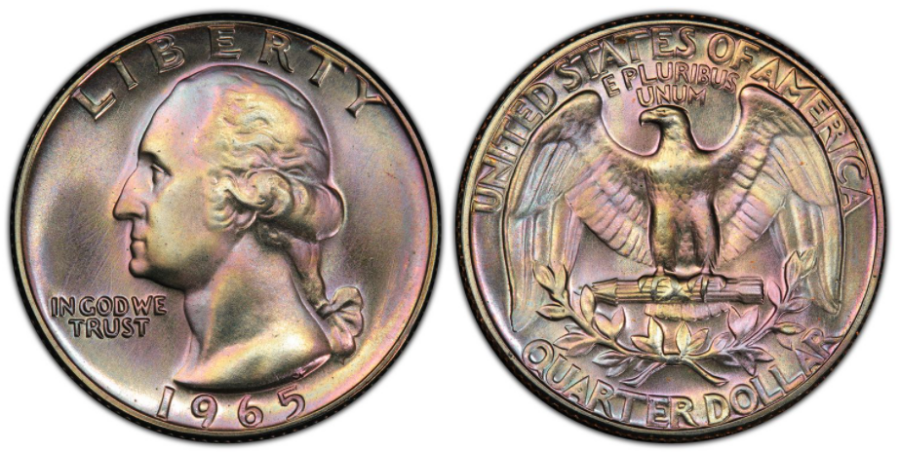
Off-Center 1965 Quarter Errors
The dies are fixed in position before striking the coin in the typical minting process. However, mint errors happen when the die is not fixed in place. The image on the coin becomes displaced.
The coin’s surface area displacement can be from 1% to 99%.
Off-center errors are uncommon because the phenomenon occurs for only a few minutes before the dies are fixed. Therefore, the number of pieces that end up in circulation is small.
Off-center Washington quarter error coins are rated by these standards –
- Perfectly centered (0%)
- Slightly off-center (1% or 2%)
- Moderately off-center (3% or 4%)
- Heavily off-center (5% or 6%)
- Very heavily off-center (7% or 8%)
An off-center 1965 quarter will have two primary measures. First, the amount of metal displaced by the missing portion of the coin. Second, how much surface area is lost to the displaced metal.
The greater the displacement and surface area, the higher the value of the off-center error coin.
1965 Silver Quarter Values Vs. 1965 Clad Quarters
If you have a 1965 silver quarter, it may be worth more than 25 cents.
The simplest method to determine if your 1965 quarter is worth more than face value? Start by weighing it.
The silver 1965 Washington quarter weighs 6.25 grams, 0.25 grams heavier than all other quarters from 1965 because of its 90% silver content.
All standard quarters minted between 1965 and 1970 are made of a copper-nickel clad composition and weigh 5.67 grams.
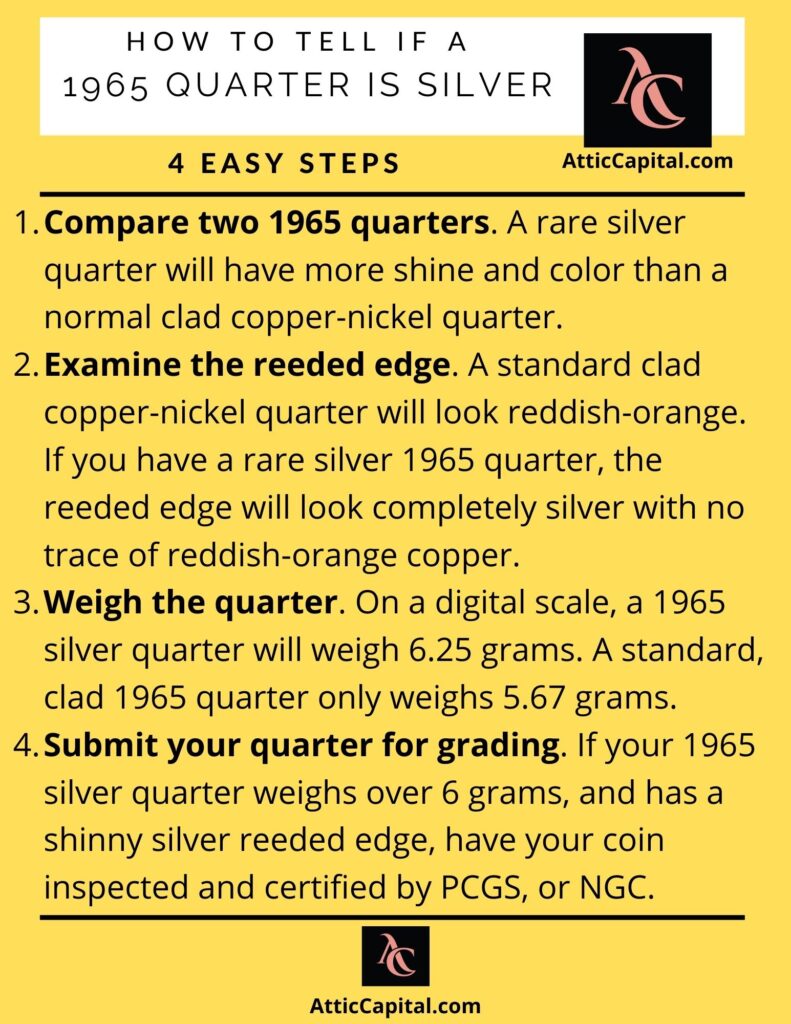
If you don’t want to buy a scale, there’s another way to determine whether your quarter is silver or clad.
Look at the edge of the coin with a magnifying glass. Determine if your quarter has a reddish-orange reeded edge, it is most likely clad and not a silver coin.
A 1965 quarter with silver on the reeded edge and no trace of copper, it’s most likely a rare silver error quarter.
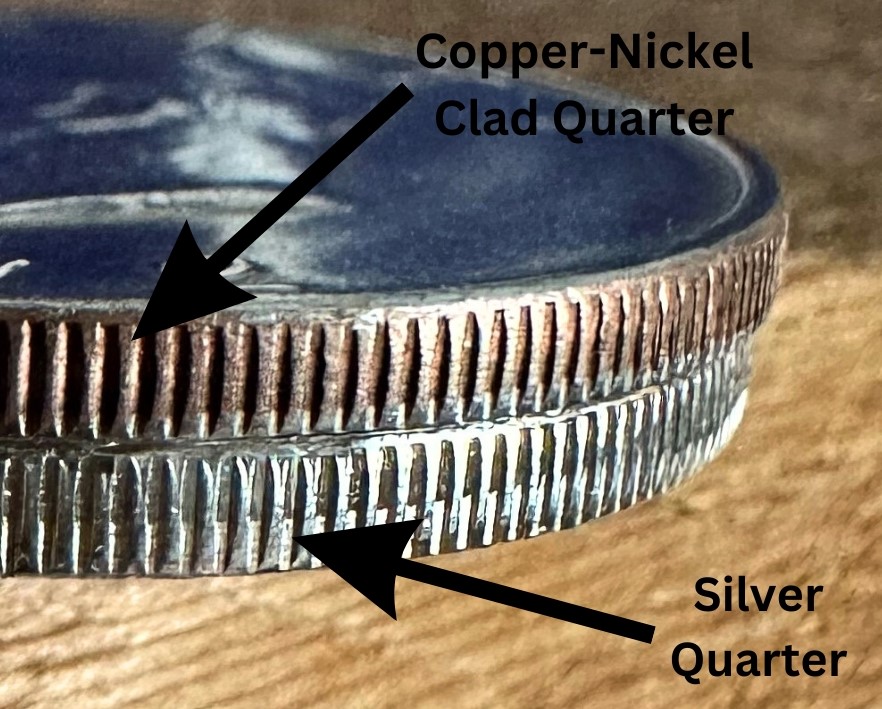
If your 1965 quarter weighs 6.25 grams and doesn’t have a reddish-orange color along the reeded edge trim, your next step should be a professional inspection by a coin dealer.
Finally, submit the coin for certification and grading to a credible agency. Here are four of them below.
- Independent Coin Graders (ICG)
- Numismatic Guaranty Corporation (NGC)
- American Numismatic Assocaiation Certifiction Service (ANCACS)
- Professional Coin Grading Service (PCGS)
These experts can assess whether the coin has any numismatic or melt value by inspecting its details and comparing it to similar rare quarters in their database.
How much is your double-weighted silver 1965 quarter worth? It depends on the condition and recent comparable sales by fellow collectors.
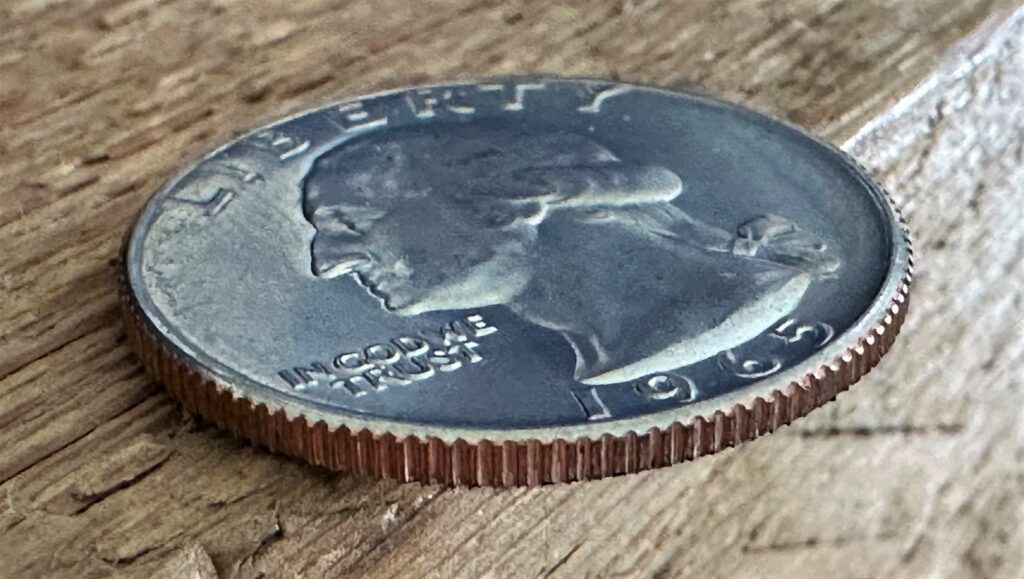
Professional Grading of 1965 Quarters
The numismatics experts at Numismatic Guaranty Corporation (NGC) and Professional Coin Grading Service (PCGS) certify coins and give them grades. These grades are very similar to what you’d see on a report card for school.
The grading scale is numerical, with 70 being very good and 100 being perfect. An uncirculated condition 1965 quarter with a grade of MS 65 is worth around $10.
If you have your coin graded by NGC or PCGS, they apply a sticker to the coin containing an identification number. You can then look up that number online and determine exactly how much it’s worth.
Next, you can bring them to a local coin show, coin auction, or coin market and see what value a numismatist might apply.
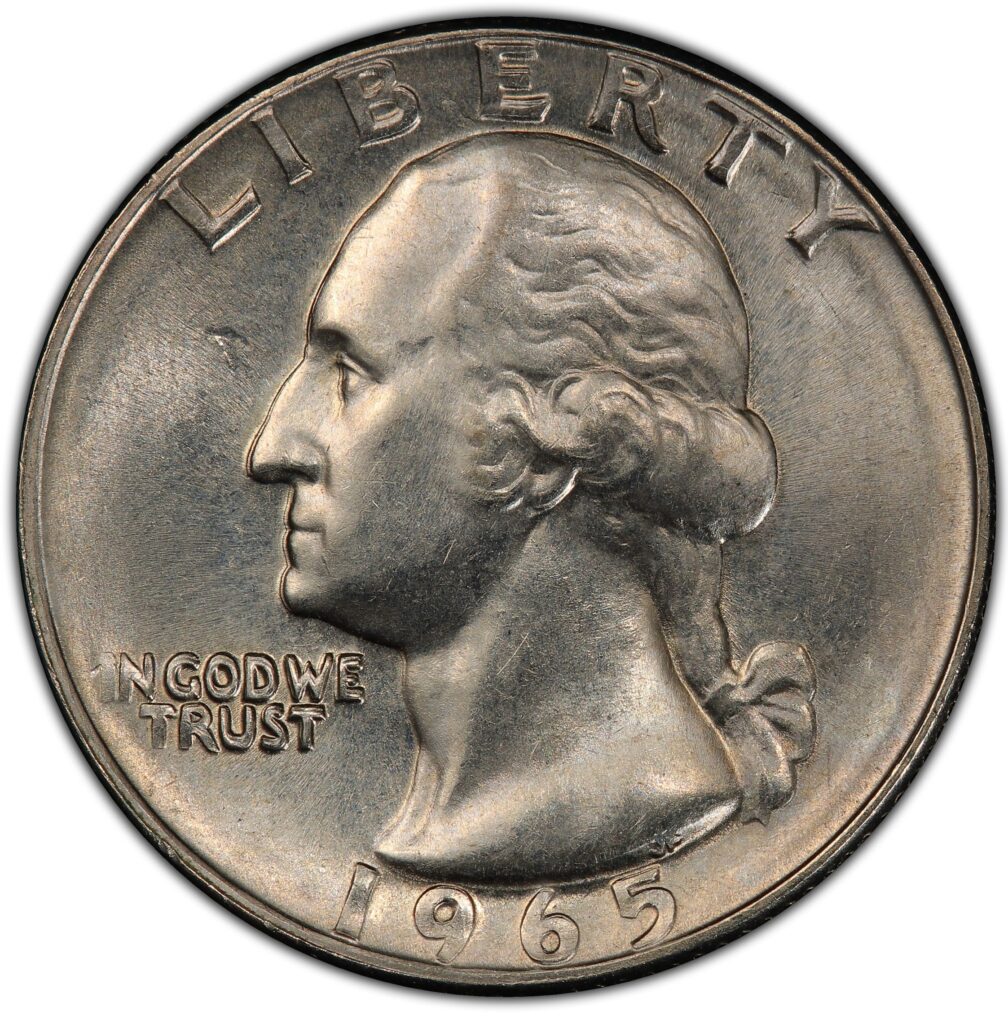
Is My 1965 Quarter Valuable?
Standard clad Washington quarters are not considered rare. Over 2 billion Washington quarters have been minted.
They are not produced anymore because they’ve been replaced by other coins with more artistic designs, such as the state quarters, and America the Beautiful quarters.
But people still love collecting quarters. They are one of the most popular collector coins because of their beautiful design, rich history, and plentiful supply.
Standard circulated 1965 quarters are worth money, but it’s only the face value of 25 cents. The average value of an uncirculated 1965 quarter is 40 cents. Just pocket change.
If you find a special coin made from silver, or with a unique mint of origin error, the value of your coin can skyrocket.
Some very rare 1965 error coins in a mint state condition have sold for as much as $7,000. If you find a more common error coin, like an off-center 1965 quarter, its value may be as high as $50 to $300, USD.
Things We Learned –
- 1965 was a transition year for the U.S. Mint when a coin shortage and public hoarding prompted changes in currency and money circulation.
- On July 23rd, 1964 the clad coin was born when Lyndon B. Johnson signed a bill authorizing coinage with 20% copper and 80% silver.
- Look closely at the reeded edge of your quarter to see if its silver or clad composition.
Want to Learn More About Coins, Here You Go –
- The best places to sell your coins online.
- How do I figure out how much my coins are worth?
- I want to learn about the history of U.S. coins, and which are most valuable.
